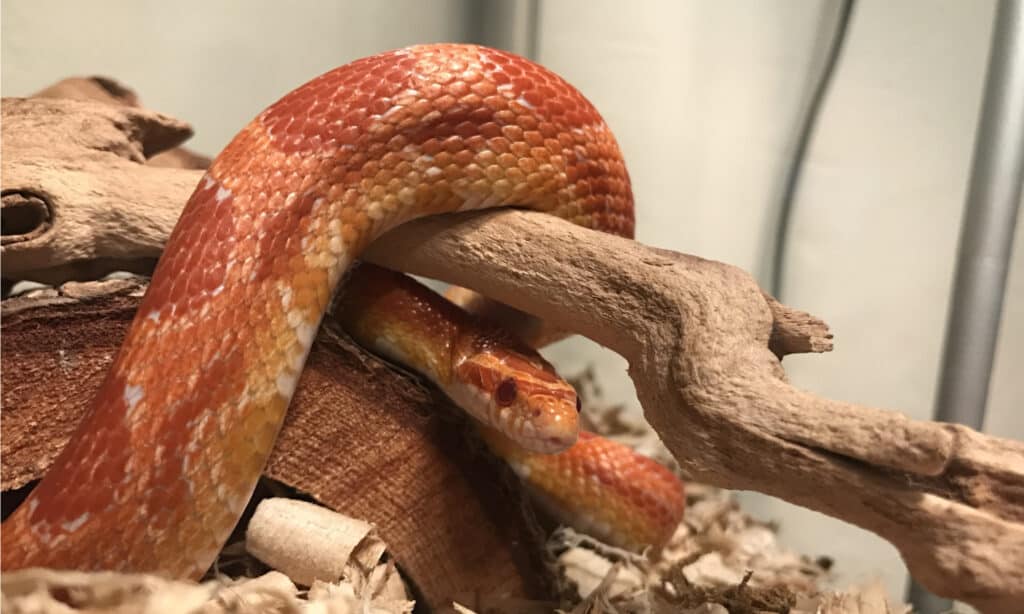
Young corn snakes make great pets for people interested in owning a snake for the first time.
©Photohobbiest/Shutterstock.com
Corn snakes are gentle reptiles that make excellent pets for starter snake pet parents. They are very docile, easy to handle, and will live a long life as long as they are provided with plenty of food and a proper terrarium.
New pet parents may get worried when they notice their beloved corn snake looking pale and suddenly hiding from them. Their skin tone looks cloudy and blue, and it looks like parts of them are falling off. These signs may sound alarming, but they are all healthy signs of a corn snake preparing to shed its skin.
Seeing a corn snake shed is completely normal and new snake owners should be aware of how often their corn snake will shed, the signs they are about to shed, and any symptoms to recognize if their corn snake needs assistance.
The Basics of Corn Snakes
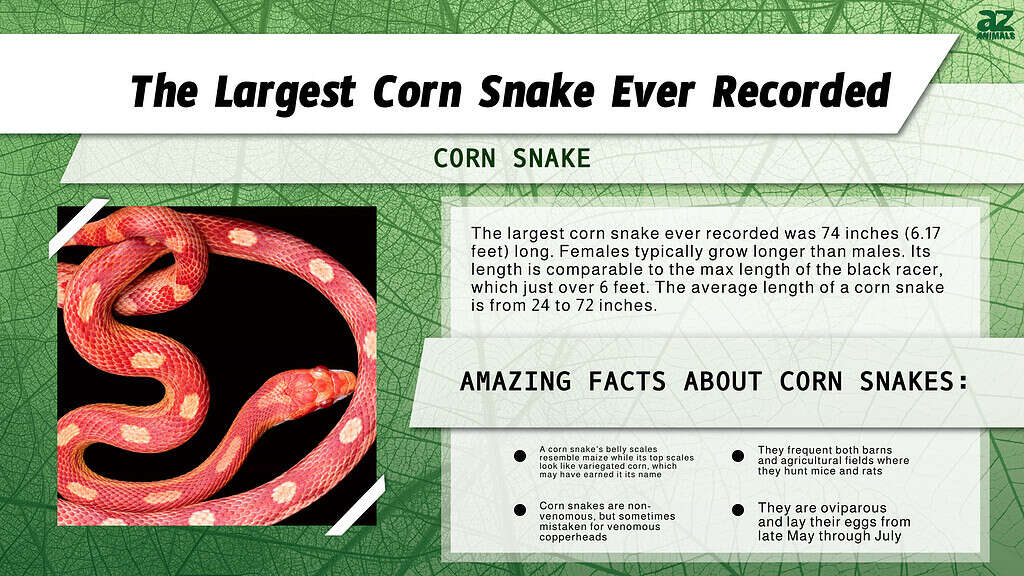
Corn snakes are native to the East Coast US, residing in wooded groves, hillsides, meadows, barns, and abandoned buildings. They are a non-venomous constrictor, meaning they catch their prey by squeezing the life out of them before swallowing them whole.
A full-sized corn snake can reach 24-72 inches and weigh anywhere from 1-3 pounds. Healthy corn snakes can live up to 23 years in captivity, provided they have easy access to a temperature-regulated terrarium, a nutritious diet, and regular care.
Corn snakes are very popular pets because they are easy to handle and rarely bite. It will take a few weeks for a corn snake to adapt to their new environment. After which, it will be safe to gently introduce yourself so they may become familiar with your scent as a companion and not a predator.
How Often do Corn Snakes Shed
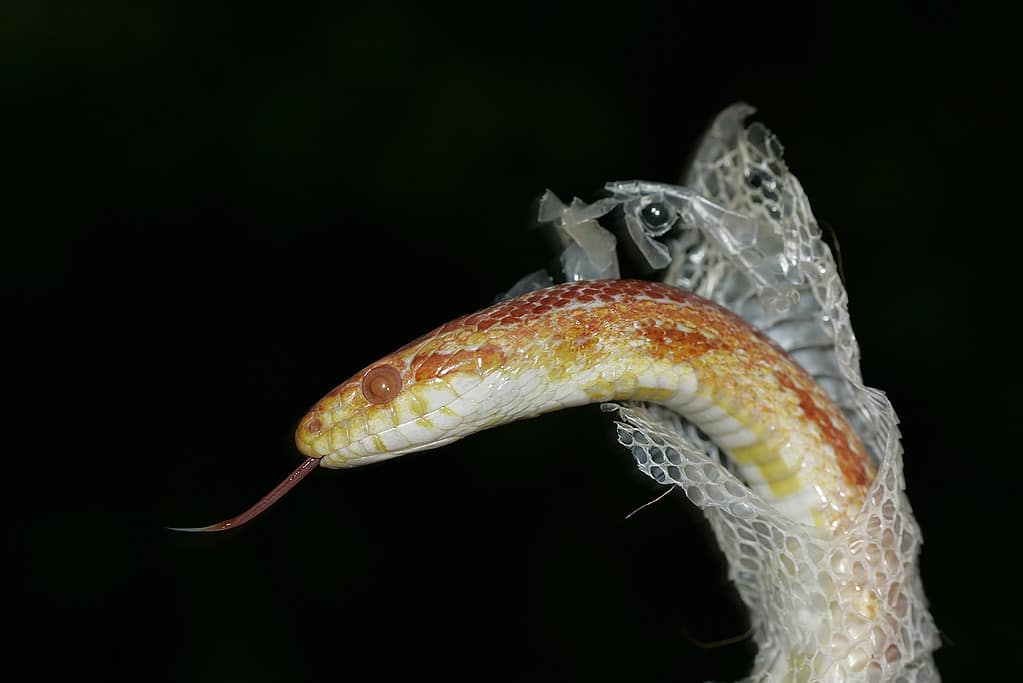
Healthy snakes shed their skin in one full piece which can be found lying in open and sunny spaces.
©Jose Bergadá/iStock via Getty Images
Depending on the age, corn snakes will shed their skin at different frequencies.
Hatching and young corn snakes shed their skin every 4-6 weeks. Young corn snakes will shed more often than mature snakes because they are still growing and reaching their mature size.
Adult corn snakes shed their skin approximately every 3 months. Mature corn snakes do not shed as frequently because they have reached their full size. Shedding will occur naturally as a method of replacing old skin cells with new and healthy cells.
The shedding process lasts between 6-9 days. During this time, corn snakes will feel vulnerable and want to be left alone to shed in peace. Pet parents should avoid touching their snakes during this process.
Why Do Corn Snakes Shed Their Skin

Snakes are vulnerable while they are shedding their skin, so they try to hide and seclude themselves until it is complete.
©Collin Glaser/iStock via Getty Images
Corn snakes, like all other snakes, have to shed their skin as a natural process of replacing old skin cells. Humans and mammals shed their skin continuously throughout the day. Reptiles like cornsnakes shed their skin in one whole piece to accommodate their growth or heal from wounds.
The process of shedding the outer layer of skin is called ecdysis. It is primarily found in reptiles like snakes and lizards, as well as insects like cicadas or arthropods like lobsters.
Healing
Shedding is a method of healing old wounds. Corn snakes do not have the same regenerative abilities as lizards where they can regrow their tails. Shedding allows corn snakes to heal injuries, scratches, and cuts sustained in the wild by replacing the damaged tissue with new and healthy tissue.
Weight Changes
Corn snakes require more time for their bodies to adjust to increased weight. Shedding their skin allows their bodies to expand to accommodate the extra weight during the growing process or manage extra ounces in their older state.
Signs A Corn Snake Is Shedding
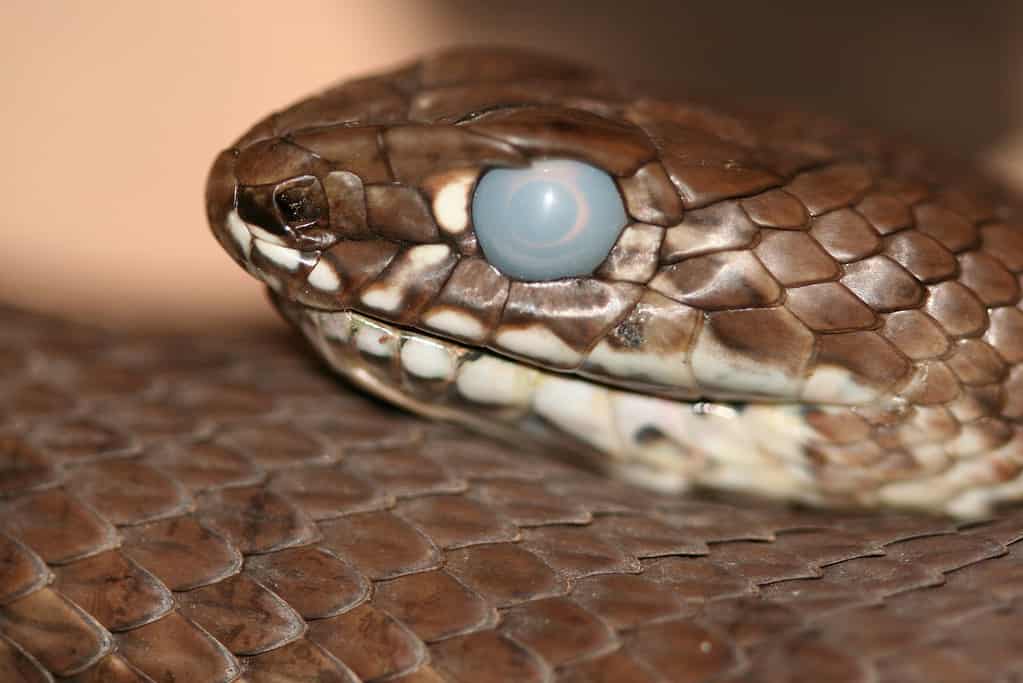
The eyes will become very cloudy right before a snake starts shedding its skin.
©Frank Buchter/iStock via Getty Images
Owners of corn snakes should recognize when corn snakes are about to shed their skin.
- Eyes turn cloudy and blue-ish.
- Eyes secrete lubricant.
- Old skin looks dull and pale.
- Hiding in humid caves or shelters more often.
- Decreased appetite.
- Acting defensive or nervous.
- Seeking rough surfaces or pools of water.
Corn snakes are vulnerable to predators in the wild. The lubricant secreted from the eyes helps in the shedding process, but it weakens their eyesight. They want to find a safe place to shed their skin where they are not exposed to predators or threats. Even in captivity, corn snakes have evolved to seek protection during this time.
How Do Corn Snakes Shed Their Skin
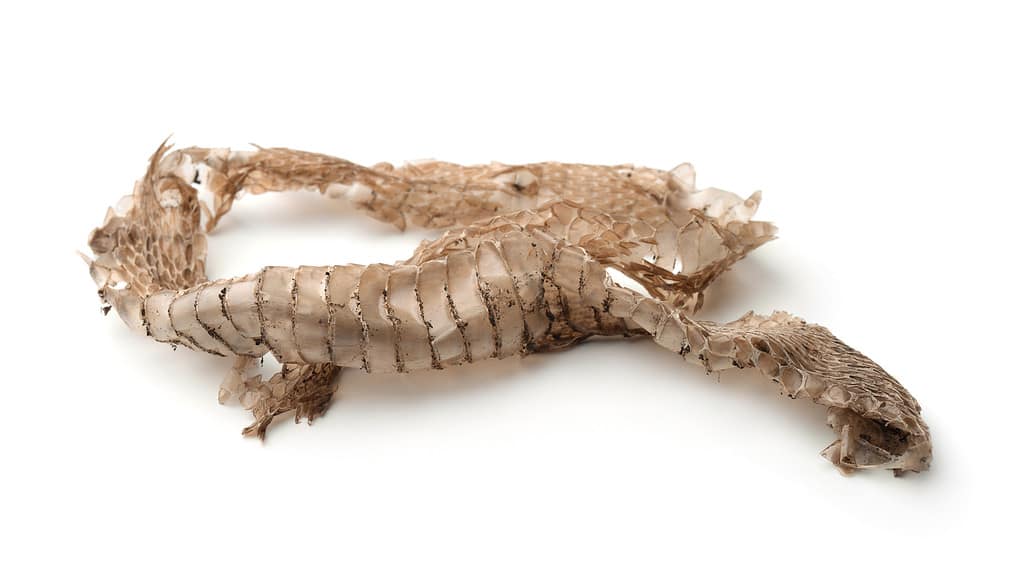
Corn snakes rub themselves against hard surfaces and soak themselves in warm water to help them remove their old skin.
©Coprid/iStock via Getty Images
After going through the steps depicted above, corn snakes will begin the shedding process.
First, they will secrete moisture and lubricant from their eyes to help the old skin slide off more easily.
Next, the corn snake will rub their face against a rough surface like a rock or tree bark to peel off the outer layer of skin.
After which, the corn snake will squeeze into small spaces, rubbing their body against the sides to pull the old and loose skin off their body. The process is very similar to removing a sock where it unravels inside out.
Corn snakes may seek out sources of warm water to help lubricate their bodies in case they are struggling to remove the dead skin.
Once the final layer has been removed, they will find a place to rest and recover to allow their new skin to adapt to the fresh air.
Shedding skin takes a lot of energy, so corn snakes will take time to recover before they return to their normal habits.
Corn Snake Shedding Complications
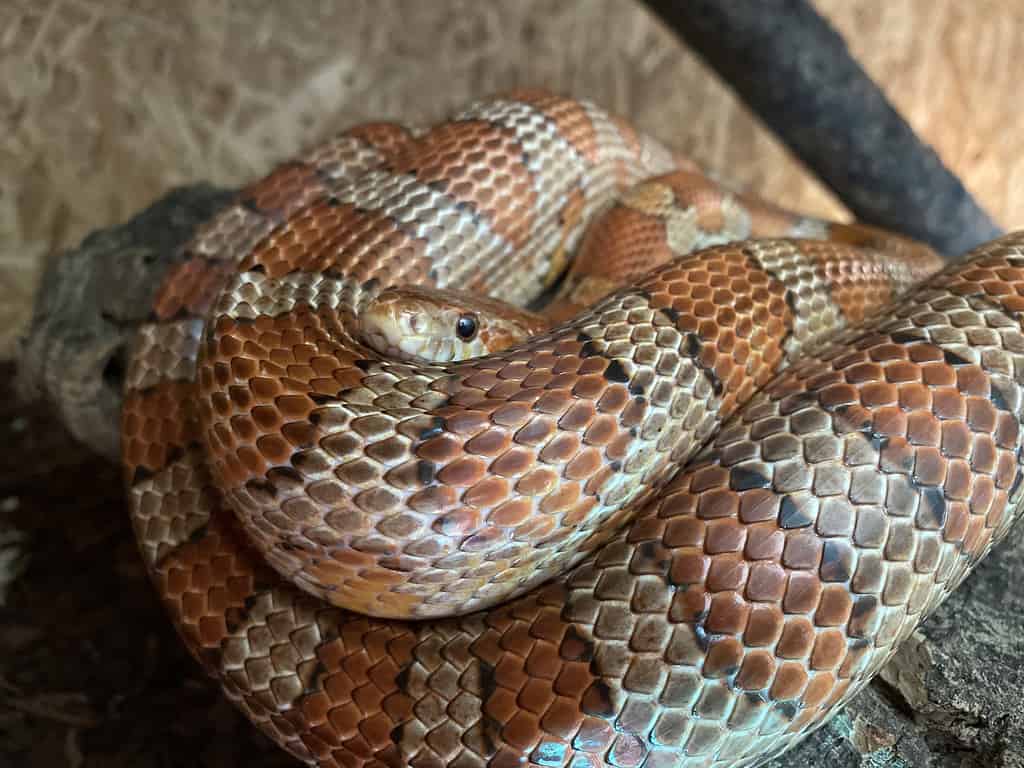
Corn snakes are very docile by nature, but will snap and try to protect itself when shedding comes because they need privacy and time to concentration.
©Tim Reimers/iStock via Getty Images
It is common for corn snakes in captivity and in the wild to experience complications during the shedding process. Dysecdysis is the term used to define a snake struggling with shedding due to humidity issues, malnutrition, or other underlying health concerns. A healthy corn snake will be able to shed their skin in one complete piece.
Humidity
Corn snakes have adapted to living in environments with moderate levels of humidity. A healthy corn snake in captivity needs 65-75% humidity in their tank at all times for them to live comfortably.
A dry climate with low humidity will cause the dead skin to stick to the fresh scales underneath. This may lead to the snake struggling to remove the skin or it comes apart in pieces.
Retained Eye Caps
Retained eye caps are when the protective layer on the eyes does not shed properly. This makes the old skin stick to the snake’s eyes and face, making it very difficult to remove. If not treated quickly, it can cause serious harm to the snake’s eyesight, leading to infections or damage to the eyes.
Malnutrition
An incomplete diet lacking in essential vitamins and minerals will make shedding more difficult for corn snakes. Lack of hydration may cause the snake to secrete inadequate amounts of lubricant over the eyes or the corn snake may not have enough energy to remove the excess skin sufficiently. Malnourished corn snakes may delay in shedding their skin or have the skin come off in pieces.
Supporting a Corn Snake with Shedding

Provide corn snakes with firm bark, stones, and a clean pool of warm water to help them shed if the need arises.
©bugphai/iStock via Getty Images
In the wild, corn snakes have to rely on themselves to sort out their shedding issues. If they are struggling with malnutrition or retained eye caps, they may not live for very long as they are easy prey for hawks.
In captivity, there are several tips a pet parent or snake enthusiast can do to support their corn snake if they are having issues shedding their skin.
- Do not try to peel off the old skin: Too much force may tear at the delicate new scales underneath and harm the corn snake.
- Check the humidity: Ensuring the humidity is at acceptable levels ensures there is enough moisture in the air for easy shedding.
- Support the environment: Fill a basin with warm water and add rough materials like tree branches and stones to help the snake shed on its own without direct interference.
- Check the diet: Check the last time the corn snake ate and see if they are getting enough essential nutrients from the provided diet.
- Call a veterinarian: Schedule an appointment with an exotic animal veterinarian if the shedding process is taking longer than expected. They can recognize any issues with the corn snake and provide professional medical advice.
Fun Facts on Corn Snake Skin
There are over 800 patterns a corn snake can have.
Corn snakes are named after the marking on their belly which resembles Native American corn, or maize.
Due to their similar color scheme, corn snakes are often mistaken for copperheads. However, corn snakes are easily distinguished from other snakes by the stripe extending from the back of the eyes to the corner of the jaw. As well as a black and white checkered pattern on their belly.
The photo featured at the top of this post is © bugphai/iStock via Getty Images
Discover the "Monster" Snake 5X Bigger than an Anaconda
Every day A-Z Animals sends out some of the most incredible facts in the world from our free newsletter. Want to discover the 10 most beautiful snakes in the world, a "snake island" where you're never more than 3 feet from danger, or a "monster" snake 5X larger than an anaconda? Then sign up right now and you'll start receiving our daily newsletter absolutely free.
Thank you for reading! Have some feedback for us? Contact the AZ Animals editorial team.







